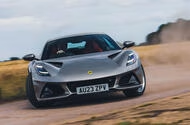Lotus is stirring excitement in the automotive world with the potential introduction of a V8 engine for its Emira sports car. This move comes as the company navigates the challenges of evolving emissions regulations and seeks to broaden the appeal of its sole combustion-engined model. Let’s dive into what this could mean for Lotus and its fans.
Why Consider a V8 for the Emira?
The current lineup for the Emira includes a supercharged V6 and a turbocharged four-cylinder, both delivering a respectable 400bhp. However, as emissions standards tighten, particularly with the upcoming Euro 7 regulations, the V6 faces compliance issues. Lotus CEO Feng Qingfeng recently shared insights during an earnings call, indicating that the company is exploring the feasibility of a V8 option to enhance performance while adhering to these stricter guidelines.
Interestingly, the V6 has maintained a loyal following, especially in the U.S., which is the largest market for sports cars. This popularity has prompted Lotus to reconsider its initial plans to phase out the V6 in favor of the four-cylinder engine supplied by Mercedes-AMG. The demand for a more powerful variant could be a game-changer, especially as Lotus aims to capture a larger share of the competitive sports car market.
What’s Next for the Emira?
The Emira is built at Lotus’s historic Hethel plant in the UK, where it achieved a record 5,272 deliveries last year. Matt Windle, the new CEO of Lotus Cars in Europe, emphasized the importance of the U.S. market, stating that the company is closely monitoring demand for the Emira. While he didn’t confirm the V8’s development, he hinted at exploring various power options to maximize the car’s potential.
One intriguing possibility is leveraging the existing relationship with AMG, which supplies engines to other high-performance brands like Aston Martin. The challenge, however, lies in adapting the mid-engine Emira’s compact frame to accommodate a larger V8 engine. It’s a delicate balance of engineering prowess and market demand.
How Does This Fit Into Lotus’s Strategy?
The prospect of a V8 Emira could also serve as a strategic move to elevate Lotus’s average selling price. With competitors like the Porsche 911 GT3, which starts at £158,200, a high-powered Emira could position Lotus as a more accessible yet thrilling alternative. This could help the brand recover from recent financial losses and re-establish its foothold in the sports car segment.
However, it’s worth noting that Lotus has faced challenges in the U.S. market due to tariffs. Shipments of the Emira were halted after a 25% tariff was imposed, and while a recent agreement between the UK and U.S. has lowered tariffs on British goods to 10%, Windle is cautious about restarting shipments until all details are clarified. This careful approach reflects Lotus’s commitment to ensuring a smooth transition back into a crucial market.
What About the Future of Electric Sports Cars?
While the focus is currently on the combustion engine, Lotus is also contemplating the future of electric sports cars. Windle acknowledged the uncertainty surrounding market readiness for such vehicles. The company had initially planned to replace the Emira with an electric model but is now taking a more measured approach, assessing consumer interest before making any commitments.
The big takeaway? Lotus’s exploration of a V8 isn’t just about boosting horsepower—it’s about adapting to market demands and regulatory challenges. Whether you’re a die-hard Lotus fan or just curious about the future of sports cars, keep an eye on how these developments unfold. The automotive landscape is shifting, and Lotus is poised to make some exciting moves.

